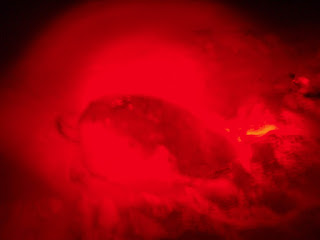After half and hour we made it to the beach. Lights off for the turtles. Our night vision quickly set in and we could see dark objects on the beach, and a couple shrimp boats 3 miles out. We walked away from the Mule, still running because the battery hadn't been charged since Steve's patrol earlier that day. A few minutes go by and we thought we saw a turtle dead ahead. As we get closer, we saw that it was just a crab trap. But wait, what's that? A fresh turtle crawl. We turn on our red headlamps and scan for another track. Only one, which meant one thing, she's up toward the dune. Steve walked first, following the track over a fallen palm tree and there she was: a huge loggerhead sea turtle.
We slowly walked up behind her to see which stage of nesting she was in. From both sides we could see that the nest cavity had been dug but we couldn't see any eggs. We watched closely for eggs to fall. Figuring that we had some time, Steve ran back for the Mule so we could do basic measurements, scan for a pit tag, and record our data. I switched my viewing spot and could see that she was definitely laying eggs. Her rear flippers would lift up as an egg would fall. Steve arrived with our gear so we quietly got to work. Sea turtles are in a trance-like state during the egg laying stage so we're able to get close without disturbing her. I couldn't find any exterior tags and Steve didn't locate any pit tags. We took straight and curved measurements. Straight length (notch to notch) = 89.1cm; straight width = 70.2cm; curved length (notch to notch) = 94.5cm; curved width = 87.4cm.
The eggs started overflowing the nest cavity. I guess she had more than she thought. She started using her rear flippers to grab sand from her sides to cover the nest. It was a sloppy process, and I speculate that if the all the eggs fit in the cavity that covering the hole would be normally be much simpler. We saw a few eggs get pushed out of the bunch and away from the hole. She eventually broke one so I grabbed the others so we could put them safely back into the nest. Every egg counts. This alternating rear flipper action lasted for at least 10 minutes. She started using her front flippers to move sand for the rear flippers to use and in the process inching forward. I grabbed a piece of wrack and put it where I thought the nest was so we could easily put the eggs back. She moved around a lot during the final stages of covering the nest, changing directions. Soon, she was finished and began the task of getting her 300 pound body back to the water. I've been pretty excited to see this part. She'd move a few feet and stop, over and over again. I think I heard her exhale deeply at one point. We watched her try to get around the palm tree and eventually go over a low spot. Closer and closer to the ocean. We crept slowly from behind. At this point an orange moon had risen over the east and it created a perfect vantage point for us to see her off. She hit the wet sand and we could her her flippers sloshing as the water got deeper, inch by inch. Soon, small waves moved in and helped mover her off. Then, the dark hump of a her shell disappeared and she was home. I hope she returns to Ossabaw.
After standing at the water's edge, Steve and I reveled in our amazing experience; we had finally witnessed one of the ocean's oldest events. Next we headed back to the nest to return the two stragglers. The spot I marked proved to be wrong, and Steve started searching for the nest. Go figure that after watching the nest get covered we'd know exactly where it was. As he was digging around, Steve found two egg shells - the one I watched the mom break, and another we hadn't seen. We used them for our research egg. I gathered our gear and we got in the Mule. Not wanting to hate ourselves for losing more eggs to depredation, we headed to a stash of screens to the north, in the dark. Using only Steve's red light as a guide, we drove slowly searching for the road marker. We weren't sure we'd find it, but then fortunately, our light was reflected back. Steve grabbed the screens and metal stakes and we carefully headed back. We covered the nest and said goodbye to NB18. While all nests are important to us, this one just jumped to the top of the list. I'll be paying close attention in 50 some days so we can catch the hatchlings emerge. After an uneventful dark drive home, we rinsed the sand off and jumped in bed. In just a few hours we'd have to get up and look for the nests we didn't get to see this night.


awesome
ReplyDelete